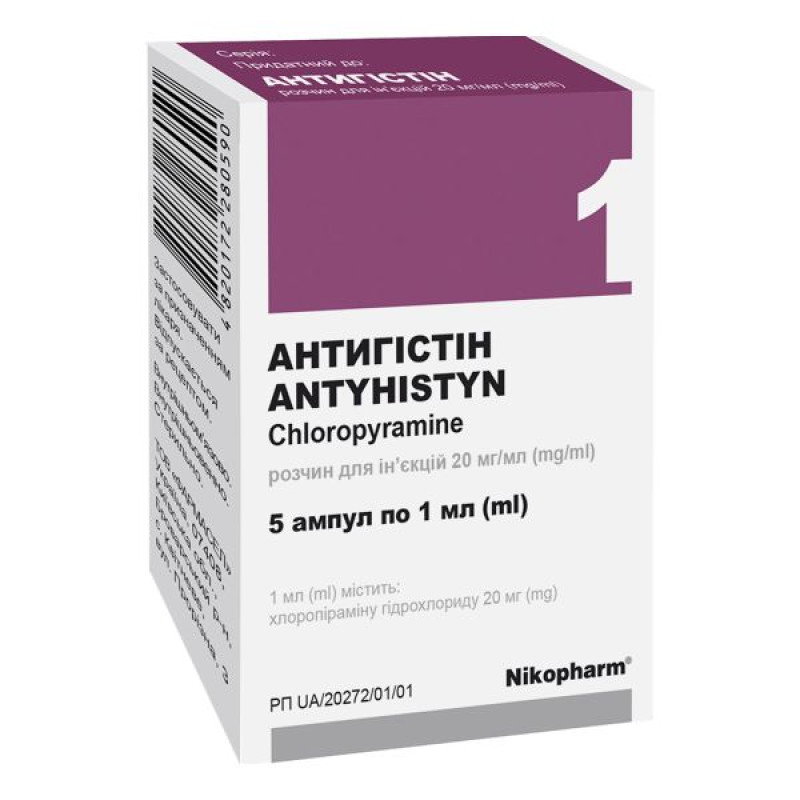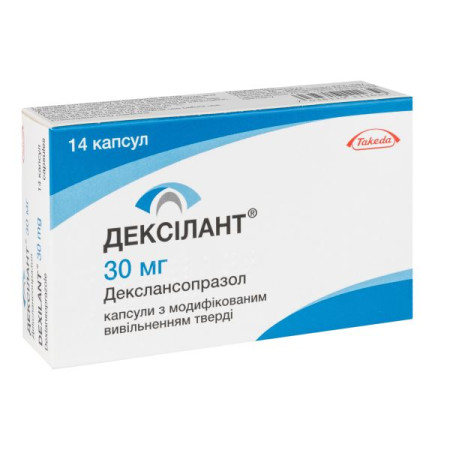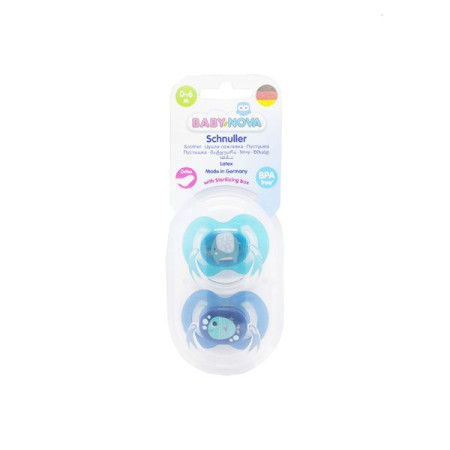Antigistin solution for injection 20 mg/ml ampoule 1 ml No. 5

Instructions Antigistin solution for injection 20 mg/ml ampoule 1 ml No. 5
Composition
active ingredient: chloropyramine;
1 ml of solution contains 20 mg of chloropyramine hydrochloride;
excipient: water for injections.
Dosage form
Solution for injection.
Main physicochemical properties: Transparent colorless or slightly yellowish liquid.
Pharmacotherapeutic group
Antihistamines for systemic use.
ATX code R06A C03.
Pharmacological properties
Pharmacodynamics.
Chloropyramine, a chlorinated analogue of tripelenamine (pyribenzamine), is a first-generation antihistamine belonging to the ethylenediamine group.
The mechanism of action of the drug is to block histamine H1 receptors.
The drug relieves general symptoms of allergic diseases, in addition to antiallergic effects, it has sedative, hypnotic, and antipruritic effects.
Pharmacokinetics.
Chloropyramine is metabolized in the liver. It is excreted mainly in the urine as metabolites. In children, the drug may be excreted faster than in adult patients. In case of impaired renal function, the excretion of the active substance may decrease.
Against the background of liver failure, the metabolism of chloropyramine slows down, which requires dose adjustment of the drug.
Indication
- Allergic diseases – seasonal allergic rhinitis; conjunctivitis; urticaria; contact dermatitis; food allergy; allergic reactions caused by drugs; allergy caused by insect bites.
- As an adjunct to the treatment of systemic anaphylactic reactions and angioedema.
Contraindication
- Hypersensitivity to any component of the drug;
- acute attacks of bronchial asthma;
- closed-angle glaucoma;
- stomach ulcer;
- acute myocardial infarction;
- arrhythmia;
- simultaneous use of monoamine oxidase inhibitors (MAOIs);
- urinary retention, prostatic hypertrophy;
- hypersensitivity to other ethylenediamine derivatives;
- pregnancy and breastfeeding.
Interaction with other medicinal products and other types of interactions
MAO inhibitors increase and prolong the anticholinergic effect of the drug. Special care should be taken when prescribing the drug simultaneously with sedatives, barbiturates, hypnotics, tranquilizers, opioid analgesics, tricyclic antidepressants, atropine, muscarinic parasympatholytics, since mutual potentiation of effects is possible.
Alcohol increases the depressive effects of the drug on the central nervous system, so during treatment with the drug, you should avoid drinking alcoholic beverages.
When used in combination with ototoxic drugs, signs of ototoxicity may be masked.
Antihistamines can suppress skin reactions during allergy testing, so the use of such medications should be discontinued a few days before a scheduled allergy skin test.
Application features
Elderly patients, debilitated patients
Chloropyramine should be prescribed with particular caution to these groups of patients, as they are more sensitive to certain side effects of antihistamines (dizziness, drowsiness, decreased blood pressure).
Due to the anticholinergic and sedative effects of the drug, special caution should be exercised when using the drug in elderly patients, patients with impaired liver function, and patients with cardiovascular disorders.
If the drug is used late in the evening, symptoms of gastroesophageal reflux may worsen.
When chloropyramine is used in combination with ototoxic agents, symptoms of ototoxicity may be masked.
Alcohol can enhance the sedative effects of antihistamines on the central nervous system.
Prolonged use of antihistamines can rarely cause disorders of the hematopoietic system (leukopenia, agranulocytosis, thrombocytopenia, hemolytic anemia). If during long-term use of the drug undesirable effects occur (fever, laryngitis, formation of ulcers on the oral mucosa, pallor, jaundice, hematomas, bleeding), it is necessary to stop treatment and monitor blood parameters.
Use during pregnancy or breastfeeding
There are no preclinical studies.
Adequate and well-controlled clinical studies in pregnant women have not been conducted, although cases have been described in which newborns whose mothers received antihistamines during the last months of pregnancy developed retrolental fibroplasia.
Therefore, the use of the drug during pregnancy or breastfeeding is contraindicated.
Ability to influence reaction speed when driving vehicles or other mechanisms
During the use of the drug, especially at the beginning of treatment, drowsiness and deterioration of psychomotor functions may occur (see section "Special instructions"). Therefore, taking into account possible adverse reactions from the nervous system, driving or working with other mechanisms should be prohibited at the beginning of therapy for a period established individually in each specific case. Later, the degree of restriction or prohibition should be determined by the doctor individually.
Method of administration and doses
Chloropyramine hydrochloride injection solution can only be administered by a doctor or nurse. The solution is administered intramuscularly. In case of anaphylactic shock or acute, severe allergic reactions, it is recommended to start treatment with intravenous administration of chloropyramine hydrochloride, and then switch to intramuscular injections or oral administration of tablets. The duration of treatment is determined by the doctor.
Adults
The daily dose for adults is usually 1–2 ml (1–2 ampoules) intramuscularly.
Children
Recommended starting dose:
- children aged 1–12 months: 1/4 ampoule (0.25 ml) intramuscularly;
- children aged 1–6 years: 1/2 ampoule (0.5 ml) intramuscularly;
- children aged 6–14 years: 1/2–1 ampoule (0.5–1 ml) intramuscularly.
In this case, it is necessary to use an insulin syringe with a needle for intramuscular injection.
The daily dose for a child should not exceed 2 mg/kg of body weight.
Elderly patients, debilitated patients
The drug should be prescribed with particular caution to these groups of patients, as they are more sensitive to certain side effects of antihistamines (dizziness, drowsiness, decreased blood pressure) (see section "Special warnings and precautions for use").
Liver dysfunction
A dose reduction may be necessary because the metabolism of the active substance is reduced in liver disease.
Kidney dysfunction
In case of impaired renal function, it is necessary to reduce the dose of the drug, since the active substance is excreted mainly by the kidneys.
Children.
Chloropyramine hydrochloride can be used in children from 1 month of age. It is contraindicated in newborns and premature infants.
Overdose
Intentional or accidental overdose of antihistamines can be fatal, especially in infants and children. In case of overdose of chloropyramine hydrochloride, symptoms similar to atropine intoxication develop: hallucinations, restlessness, ataxia, impaired coordination of movements, athetosis, convulsions. In children, a state of excitement dominates. Dry mouth, dilated pupils, flushing, sinus tachycardia, urinary retention, fever may also be observed. In adults, fever and flushing are not always observed, the period of excitement is accompanied by convulsions and postictal depression. In addition, coma and cardiopulmonary collapse may occur, which within 2–18 hours can lead to death.
Monitoring of cardiopulmonary function is recommended. Treatment is symptomatic.
The antidote is unknown.
Side effects
When using chloropyramine hydrochloride, the following adverse reactions may occur.
From the cardiovascular system: arterial hypotension, tachycardia, arrhythmia.
From the blood system: leukopenia, agranulocytosis, thrombocytopenia, hemolytic anemia, other pathological changes in the blood.
From the nervous system: sedative effect, increased fatigue, dizziness (vertigo), ataxia, nervousness, tremor, convulsions, headache, euphoria, encephalopathy, blurred vision, drowsiness, deterioration of psychomotor functions.
On the part of the organs of vision: increased intraocular pressure, glaucoma.
On the part of the digestive system: pain and discomfort in the epigastric region of the stomach, dry mouth, nausea, vomiting, diarrhea, constipation, anorexia, increased and decreased appetite, increased symptoms of gastroesophageal reflux.
Renal and urinary disorders: dysuria, urinary retention.
Skin and subcutaneous tissue disorders: photosensitivity, allergic reactions.
Musculoskeletal and connective tissue disorders: myopathy.
On the part of the immune system: allergic reactions, including skin hyperemia, rash, itching, urticaria, angioedema.
Other: changes at the injection site.
Reporting of suspected adverse reactions
Reporting adverse reactions after the registration of a medicinal product is important. This allows monitoring of the benefit/risk ratio when using this medicinal product. Medical and pharmaceutical professionals, as well as patients or their legal representatives, should report all cases of suspected adverse reactions and lack of efficacy of the medicinal product via the Automated Information System for Pharmacovigilance at the link: https://aisf.dec.gov.ua.
Expiration date
2 years.
Storage conditions
Store in original packaging at a temperature not exceeding 25 ° C. Keep out of the reach of children.
Packaging
1 ml in a polyethylene ampoule. 5 ampoules in a cardboard pack.
Vacation category
According to the recipe.
Producer
LLC "PHARMACELL".
Ukraine, 07408, Kyiv region, Brovarskyi district, Kvitneve village, Prorizna st., 3.
There are no reviews for this product.
There are no reviews for this product, be the first to leave your review.
No questions about this product, be the first and ask your question.







